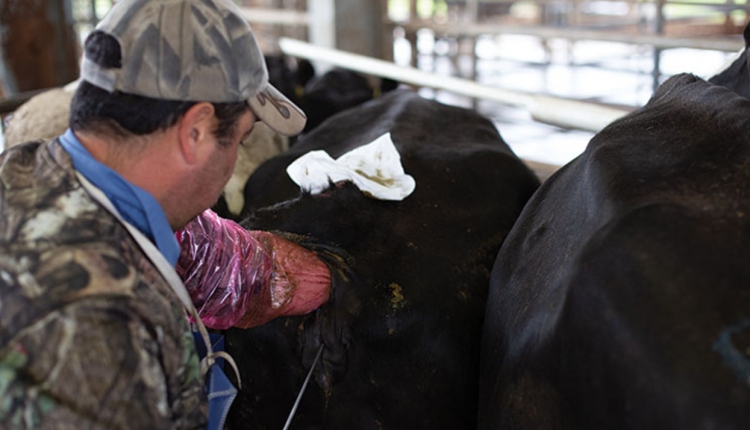The author is professor of animal sciences at Kansas State University, Manhattan.
We often think the relationship between milk production and fertility is a relatively recent concern. But, in fact, it has been debated for quite some time. Quoted back in a 1929 Minnesota Dairy Bulletin was this gem: "In recent years, the opinion has been held by a large number of dairymen that difficulties with breeding accompany high milk production - the conclusion has been drawn that as milk yield has increased during the same interval that the two (milk yield and fertility) bear the relation of cause and effect."
Milk yield and reproductive outcomes are considered to be the standard economic barometers of a dairy operation. No one disagrees that global milk yield per cow has grown steadily during the past four decades. In fact, annual milk yield per cow in the U.S. has gone from 12,998 pounds in 1970 to 21,149 pounds last year. That is an 8,151-pound gain in three decades. However, the conclusion reached by many (based on earlier studies dating to the 1980s) is the existence of an overall antagonism between milk yield and reproduction. The antagonistic relationship is generally perceived to have reduced fertility as a consequence of higher milk yields.
Widely debated
The perception of a production-reproduction antagonism has been repeatedly challenged, thus triggering a passionate debate on the true nature of this association. Indeed, a growing list of studies now provide evidence for high milk yield being favorably associated with fertility, where higher-producing cows are also the ones most likely to become pregnant. Similarly, higher-producing herds are commonly reported to have better reproductive performance.
Further supporting evidence is based on a recent USDA study, where fertility has rebounded since the incorporation of genetic merit for daughter pregnancy rate (DPR) despite no apparent slowing down on gains in milk production per cow. DPR is a genetic measure of fertility for a bull's daughters. A value of 1 equals 1 percent greater pregnancy rate in 21 days.
In addition, both Holsteins and Jerseys showed gains in DPR after implementation of genetic evaluations for productive life (PL) in 1994 and DPR in 2003. As a reminder, PL is a genetic estimate of future productive life of daughters; a value of 1 is equal to 1 additional month of productive life. Use of PL may have reversed the negative genetic trajectory in pregnancy rate because of the negative association between days open and productive life. Bulls of superior genetic merit for DPR, which has a negative relationship with daughter days open, have daughters with reduced culling for reproduction and thus longer PL.
What else has changed during the past decades that may be responsible for declining fertility?
What are the appropriate measures of milk yield? Short-term yields of 60 or 90 days may be useful when testing the immediate influence of milk production at or near the time of first inseminations, but are inherently less reliable for estimating total lactation performance. Component-corrected milk yields would be more appropriate because they account for most of the energy content in fluid milk.
Meanwhile, actual 305-day yields more accurately reflect the entire lactation but do not assess the metabolic environment during the actual breeding period. However, actual 305-day yields are not very representative of inherent differences in metabolic needs of first lactation growing cows at the same level of production because older cows have no growth requirement. Age-adjusted or 305-day mature equivalent (2×-305-day ME) records adjust not only for parity but for differences in daily milking frequency, age at calving, month of calving, duration of lactation, and region of the country where the cow resides.
The same yield in one region or country that may be considered to be "high" is considered to be "moderate" or "low" somewhere else. Furthermore, these differences in yield are often confounded with breed and nutritional factors. Lower-yielding cows in pasture-based systems are at a different metabolic status than full-fed cows housed in confinement. Considerations of what is high, moderate, or low production must be defined within a given production system and genetic base.
Defining performance
Multiple measures of reproductive performance pose additional challenges in our ability to clearly define the problem. Historically, genetic-based studies have assessed measures that are available from dairy record processing centers including conception rate, number of services per conception, days open, and calving intervals. Each of these variables is strongly controlled by management decisions that superimpose, and in some cases may supersede, the inherent biology.
One can manipulate days open and calving intervals by changing the duration of the voluntary waiting period, days in milk to culling, or designating nonpregnant cows as a "do not breed." For example, conception rate varies based on days in milk when insemination occurs whether after detected estrus or timed insemination. Further, heat detection rate, and thus pregnancy rate, may vary according to variously applied estrus-detection devices including heat mount patches, radio-telemetric rump-mounted pressure sensors, or other activity monitors.
Need a fresh approach
What we need is a new way to examine all these confounding factors. One of my bright young colleagues at Kansas State University (Nora Bello) is cooperating with others at Michigan State University to find new answers to these old problems. They are examining both individual cow level effects and individual herd level effects in the same sophisticated statistical models. Their results are quite interesting. For example, while herd level effects may show negative relationships between milk yield and reproductive performance, individual cows within herds may show just the opposite trend (more milk and better fertility). More to come later.
Click here to return to the Reproduction E-Sources
1111_740
We often think the relationship between milk production and fertility is a relatively recent concern. But, in fact, it has been debated for quite some time. Quoted back in a 1929 Minnesota Dairy Bulletin was this gem: "In recent years, the opinion has been held by a large number of dairymen that difficulties with breeding accompany high milk production - the conclusion has been drawn that as milk yield has increased during the same interval that the two (milk yield and fertility) bear the relation of cause and effect."
Milk yield and reproductive outcomes are considered to be the standard economic barometers of a dairy operation. No one disagrees that global milk yield per cow has grown steadily during the past four decades. In fact, annual milk yield per cow in the U.S. has gone from 12,998 pounds in 1970 to 21,149 pounds last year. That is an 8,151-pound gain in three decades. However, the conclusion reached by many (based on earlier studies dating to the 1980s) is the existence of an overall antagonism between milk yield and reproduction. The antagonistic relationship is generally perceived to have reduced fertility as a consequence of higher milk yields.
Widely debated
The perception of a production-reproduction antagonism has been repeatedly challenged, thus triggering a passionate debate on the true nature of this association. Indeed, a growing list of studies now provide evidence for high milk yield being favorably associated with fertility, where higher-producing cows are also the ones most likely to become pregnant. Similarly, higher-producing herds are commonly reported to have better reproductive performance.
Further supporting evidence is based on a recent USDA study, where fertility has rebounded since the incorporation of genetic merit for daughter pregnancy rate (DPR) despite no apparent slowing down on gains in milk production per cow. DPR is a genetic measure of fertility for a bull's daughters. A value of 1 equals 1 percent greater pregnancy rate in 21 days.
In addition, both Holsteins and Jerseys showed gains in DPR after implementation of genetic evaluations for productive life (PL) in 1994 and DPR in 2003. As a reminder, PL is a genetic estimate of future productive life of daughters; a value of 1 is equal to 1 additional month of productive life. Use of PL may have reversed the negative genetic trajectory in pregnancy rate because of the negative association between days open and productive life. Bulls of superior genetic merit for DPR, which has a negative relationship with daughter days open, have daughters with reduced culling for reproduction and thus longer PL.
What else has changed during the past decades that may be responsible for declining fertility?
- Numbers of U.S. dairy farms fell from 329,680 in 1980 to 131,509 in 1992, to 53,127 in 2010, so each employee is expected to manage more cows per person.
- Since 1970, herd size has grown from 18 to over 172 cows.
- In 1980, only 4 percent of dairy farms were milking more than 100 cows. By 2009, 23 percent of farms had over 100 cows.
- In 1980, 33 percent of the milk was produced on farms of more than 100 cows; whereas in 2009, 83.6 percent of milk was produced on farms with more than 100 cows.
- In 1980, there were hardly any herds milking more than 500 cows, but by 2009, 5.1 percent of herds milked 500 or more cows accounting for nearly 60 percent of the total milk output in the U.S.
- Breeding strategies have changed from natural service to overwhelming prevalence of artificial insemination and ovulation synchronization programs. More than 43 percent of U.S. dairy farms are using some ovulation synchronization program, but its use varies among regions of the U.S.
- Confinement housing where cows are housed almost exclusively on concrete after first calving has become vogue. Fewer cows are in pasture or dirt lots for parts of lactation.
What are the appropriate measures of milk yield? Short-term yields of 60 or 90 days may be useful when testing the immediate influence of milk production at or near the time of first inseminations, but are inherently less reliable for estimating total lactation performance. Component-corrected milk yields would be more appropriate because they account for most of the energy content in fluid milk.
Meanwhile, actual 305-day yields more accurately reflect the entire lactation but do not assess the metabolic environment during the actual breeding period. However, actual 305-day yields are not very representative of inherent differences in metabolic needs of first lactation growing cows at the same level of production because older cows have no growth requirement. Age-adjusted or 305-day mature equivalent (2×-305-day ME) records adjust not only for parity but for differences in daily milking frequency, age at calving, month of calving, duration of lactation, and region of the country where the cow resides.
The same yield in one region or country that may be considered to be "high" is considered to be "moderate" or "low" somewhere else. Furthermore, these differences in yield are often confounded with breed and nutritional factors. Lower-yielding cows in pasture-based systems are at a different metabolic status than full-fed cows housed in confinement. Considerations of what is high, moderate, or low production must be defined within a given production system and genetic base.
Defining performance
Multiple measures of reproductive performance pose additional challenges in our ability to clearly define the problem. Historically, genetic-based studies have assessed measures that are available from dairy record processing centers including conception rate, number of services per conception, days open, and calving intervals. Each of these variables is strongly controlled by management decisions that superimpose, and in some cases may supersede, the inherent biology.
One can manipulate days open and calving intervals by changing the duration of the voluntary waiting period, days in milk to culling, or designating nonpregnant cows as a "do not breed." For example, conception rate varies based on days in milk when insemination occurs whether after detected estrus or timed insemination. Further, heat detection rate, and thus pregnancy rate, may vary according to variously applied estrus-detection devices including heat mount patches, radio-telemetric rump-mounted pressure sensors, or other activity monitors.
Need a fresh approach
What we need is a new way to examine all these confounding factors. One of my bright young colleagues at Kansas State University (Nora Bello) is cooperating with others at Michigan State University to find new answers to these old problems. They are examining both individual cow level effects and individual herd level effects in the same sophisticated statistical models. Their results are quite interesting. For example, while herd level effects may show negative relationships between milk yield and reproductive performance, individual cows within herds may show just the opposite trend (more milk and better fertility). More to come later.
1111_740










